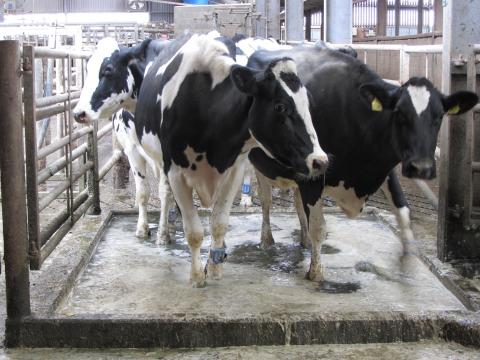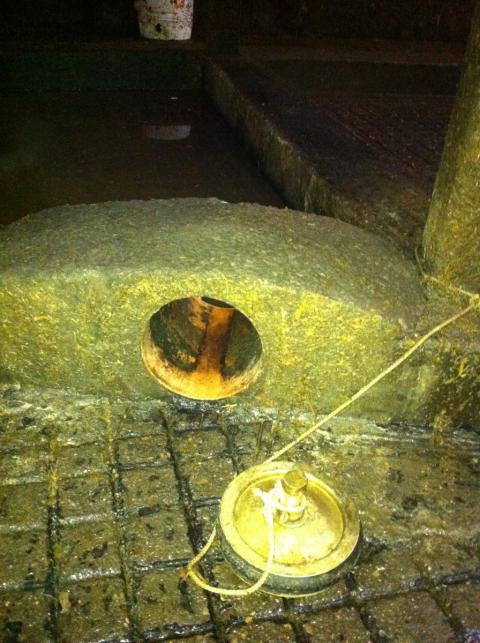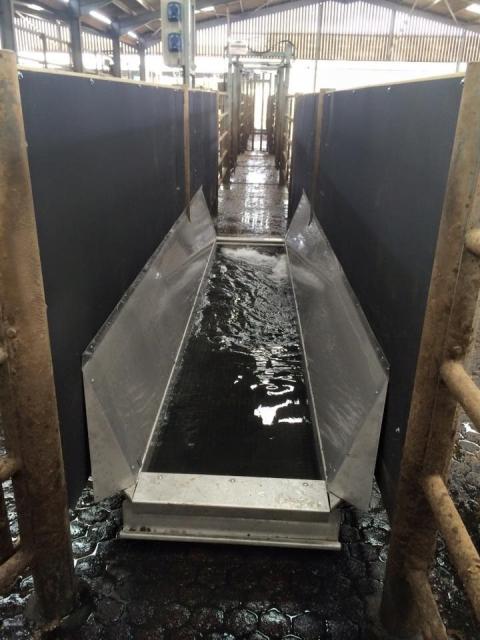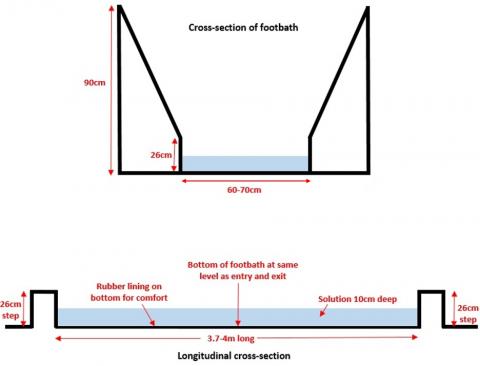By Sara Pedersen BSc(Hons) BVetMed CertCHP DBR MRCVS,
RCVS Specialist in Cattle Health and Production, Farm Dynamics Ltd, Cowbridge, Vale of Glamorgan
Why footbath?
Footbathing plays an important role in the prevention and control of digital dermatitis (DD) alongside improved hygiene and slurry management and early treatment of active lesions. Once cows become infected with DD, unless treated promptly with appropriate topical antibiotics, they invariably are infected for life. Following infection the DD bacteria can burrow deep into the skin and wall themselves off, lying dormant. Under the right conditions these lesions become active again, driving new outbreaks and spreading infection. Therefore the major role of the footbath is to prevent the resurgence of these old inactive, chronic lesions (Photo One) in addition to helping keep feet cleaner which also reduces new infections.
Who should I footbath and when?
Often it is just the milking cows that are footbathed, however, it is important to include the dry cows and youngstock too. Heifers infected pre-calving are more than twice as likely to have DD in their 1st lactation, as well produce 350kg less milk and take longer to get in calf in comparison to heifers that have had no DD.
The frequency of footbathing required will vary from farm to farm and should be formulated and reviewed as part of the herd health plan alongside the farm’s vet, however, generally the more frequent the better. Where risk is high, on some farms daily footbathing is necessary to keep infection under control. If purchasing stock then it is also important that they are footbathed on arrival as part of the farm’s biosecurity measures to reduce the risk of bringing in new strains of DD onto the farm.
Where should I footbath?
Footbath design is crucial in making the process easy for both yourself, and more importantly, the cows. A footbath is most effective when incorporated into the cow’s normal routine so there is limited disruption to cow flow, with the exit of the parlour being a popular place.
How should I design my footbath?
Good cow flow through the footbath is essential to reduce faecal contamination and displacement of the footbath contents as well as ensuring minimal disruption to cow traffic. Although very popular, rigid plastic baths with pronounced ridges on the bottom are uncomfortable for cows to walk through and are not recommended. Instead permanent ‘built in’ footbaths provide better cow comfort and cowflow. Cows do not like stepping up or down into a bath, therefore the bottom of the bath should be on the same level as the entry/exit points and also provide the cow with grip as she walks, although ridged bottom baths should be avoided. Rubber matting on the bottom of the bath is another option and will provide grip as well as comfort as the cow walks through, especially if she is lame.
Whilst there are mixed opinions regarding use of a prewash bath, generally it is felt more effective to have a single, longer chemical bath instead of having separate prewash and chemical baths. Prewash baths are used to reduce contamination of the chemical bath, however, some studies have shown that the opposite occurs with an increase in faecal contamination of the chemical bath. In addition, if the foot is already wet on entry to the chemical bath it is less able to absorb the solution. Prewash baths also add a significant amount of water to the slurry handling system.
Length, width and depth of the bath are also critical. It is recommended that each foot should be ‘dunked’ at least twice, preferably three times, requiring a footbath 3.7-4 metres long. Reducing the width of the bath to 60-70cm reduces the filling cost whilst still allowing cows to comfortable walk through the footbath (Figure One). Whilst wider footbaths are often used for ease of cowflow (Photo Two), these can be costly to fill if they are to be long enough to achieve the required ‘dunks’.
Fixing sloping side panels to the edge of the bath helps ensure cows place their feet in the solution rather than on the sides of the bath as well as reducing loss of solution through splashing. High entry and exit steps also reduce solution loss and increase the number of ‘dunks’ achieved, with 26cm steps the recommendation. To ensure feet are completely immersed in the solution it should be filled to a depth of ~10cm.
As well as considering cow flow when designing the footbath it is important to pay attention to its position and how easy it is to fill, empty and clean. The easier it is to maintain, the more frequently it will be used. A wide-bore bung can help with rapid emptying and easier cleaning out (Photo Three) although fully automated footbaths are available to make footbathing hassle-free (Photo Four).
What should I use?
Despite the widespread practice of footbathing there are relatively few robust clinical studies on the effectiveness of the various agents that are commonly used. When deciding what to use the following should be considered: ease of use, product safety, disposal, costand, most importantly, is it doing the job.
It is a common misbelief that footbathing agents act as ‘treatments’, however, they are predominantly acting as disinfectants. Careful consideration must be taken to select the most appropriate agent and concentration for the farm. This should be determined in conjunction with the farm’s vet, with regular reviews to ensure that the regime is effective. Disinfectants that have been shown to be effective when used in footbaths include 2-5% formalin and 5% copper sulphate. Peracetic acid and hypochlorite parlour washings have not been found to be effective forms of controlling DD.
Whilst formalin and copper sulphate have been shown to be effective and are the most commonly used agents, there are a number of precautions that must considered if they are used. Formalin is a known carcinogen and therefore sufficient health and safety procedures must be in place to avoid exposure to those that are handling or exposed to it. These include use of a respirator during handling and ensuring that footbaths are situated in well ventilated areas. Safe disposal of both formalin and copper sulphate into the slurry management system must also be considered in order to reduce the risk of environmental contamination and, in the case of copper sulphate, build-up of heavy metals in the soil if slurry is then spread on pasture.
Regardless of which chemical is used, it is important to remember that it is unlikely to work if it can’t get to the target area. The full potential of the agent will not be achieved if the cows’ feet are dirty or do not receive sufficient ‘dunks’ in the solution. Ensuring good, calm cowflow through the footbath also reduces the risk of the agent used splashing up onto udders which could create both a milk contamination and mastitis risk.
Accurate measurements of the footbath must be taken to determine its volume when full so that sufficient agent is added to achieve the desired concentration. As a general rule of thumb the footbath should contain one litre for every cow that passes through it i.e. a 200 litre footbath must be changed every 200 cows. However, this will depend on the level of contamination in the footbath and also the agent used.
Although highly contagious, digital dermatitis can be controlled effectively in a herd through an integrated approach. This includes improved hygiene to reduce exposure to infection through better slurry management, early and effective treatment of new lesions with a topical antibiotic and footbathing to both reduce infection pressure and prevent the recurrence of chronic lesions. Forfootbathing to be effective, design is crucial to maximise cowflow, minimise contamination and also ensure that the most important thing does go into the footbath – the foot!
Photo One: The main aim of footbathing is to disinfect feet to reduce new infections, as well as prevent chronic, inactive infections (left), re-emerging as active infections (circled on right).
Photo Two: Wider footbaths can aid cowflow but still need to be 3.7-4m long to achieve the required foot ‘dunks’.
Photo Three: The footbath must be designed for ease of emptying and cleaning out, a large bore bung can help this.
Photo Four: Automatic footbaths that empty and refill after a set number of cows are available.
Figure One: Recommended design for effective footbathing based on Dairyland Initiative guidelines.





